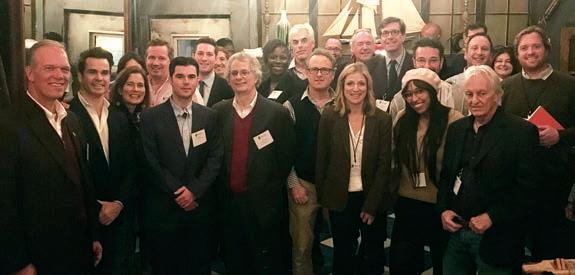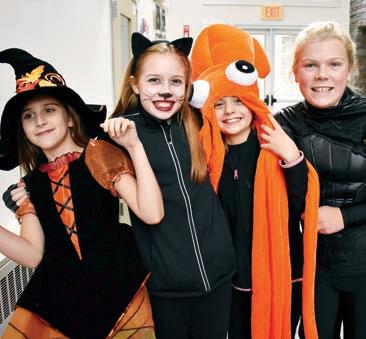
14 minute read
Hands-On Learning
In all three divisions, Rectory teachers weave hands-on learning opportunities into the curriculum. Whether they are measuring, dissecting, or mastering a new instrument, the process of experimenting with trial and error teaches students to learn from their mistakes and work through solutions.

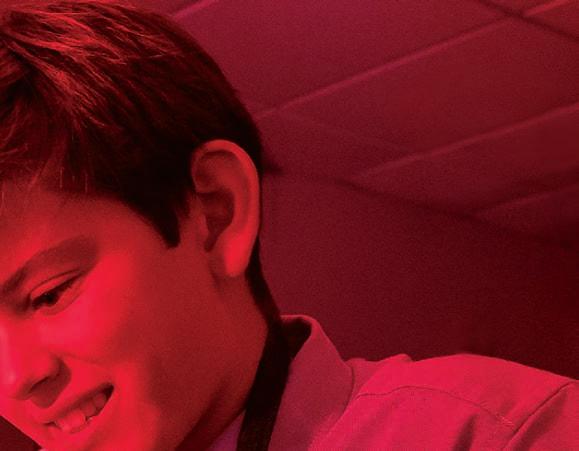
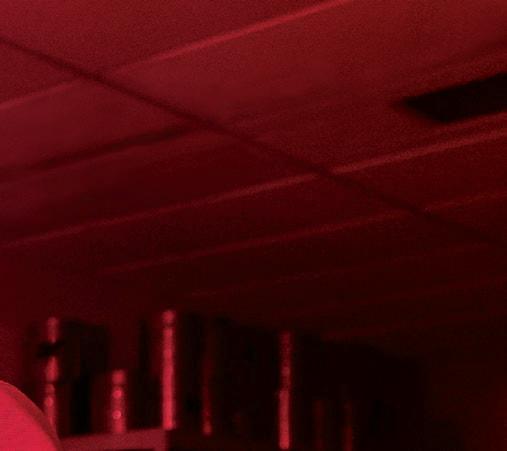
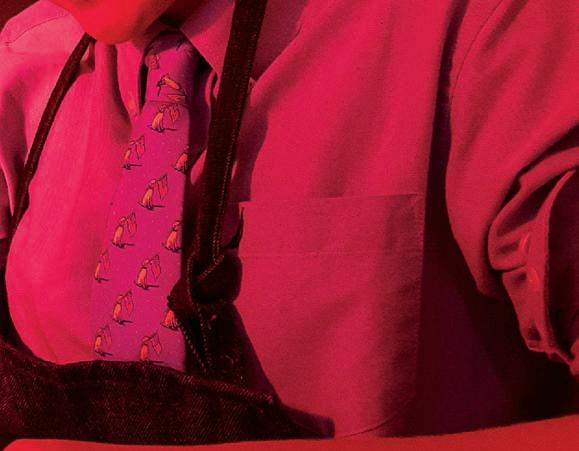


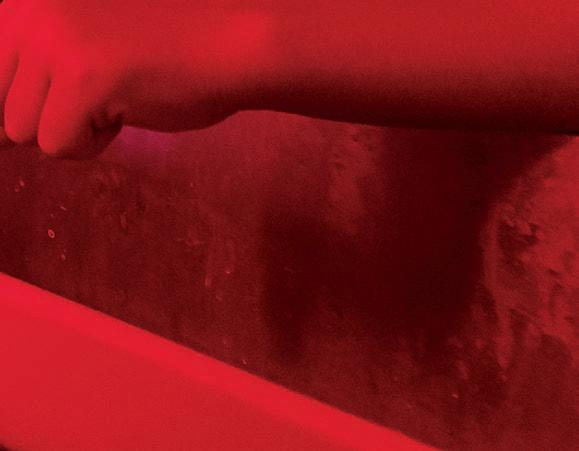
In the classrooms, our teachers broaden students’ experiential learning by encouraging them to engage with each other to fi nd answers. New middle school elective offerings like needlepoint, coding, woodshop, and model plane building open up further opportunities to learn. Students can collaborate and engage in kinesthetic learning that is imperative for continued success in the classroom. This approach has proven to be a far more popular way of learning with students, resulting in more engagement and a greater understanding of the material. >>>

Simply put, children and people learn by doing. With caring teachers to support, guide, and extend a child’s hands-on play, children’s learning is amplified to not just doing but knowing.


Children at Rectory: Exploration In Multi-Sensory Classrooms by Erin Hayden, Director of Children at Rectory
At the heart of today’s educational trends is the concept of bringing lessons from abstract to concrete. In practice, this means “closing the book” (quite literally) and providing students with practical learning experiences that are inquiry-based and have real-world application.
Experiential or “hands-on” learning requires students to think critically and engage with the content of study. Through this process, students learn to fail and try again, work collaboratively, apply knowledge to solve challenges, and make emotional attachments to experiences. In classrooms where experiential learning takes place, the teacher no longer has a “stand and lecture” style but rather a “guide by the side” approach, often allowing discoveries and knowledge to be gained by students and the teacher.
In the Children at Rectory (CARe) classrooms, children engage all their senses in each experience, gaining knowledge of content as they play. Experiences at CARe have very few limitations placed on them. Children are allowed to paint their arms and hands to feel the texture of the paint. They can taste the playdough we make (although it is extremely salty), and they can taste, touch, smell, and feel the “guts” of a pumpkin. In a classroom where 99.9% of the students cannot academically read or write, hands-on exploration provides foundational knowledge in all areas of content.
Early childhood teachers are experts in hands-on learning, but this approach is necessary for all ages and all learning styles. The information students gain from handson exploration cannot be replicated in any other way. While hands-on learning can be “messy,” it isn’t exclusively reserved for sensory exploration. Multi-sensory hands-on learning experiences happen throughout the day in literacy, math, science, social/emotional learning, and kinesthetic experiences. When exploring a story, such as the Princess and the Pea, teachers recreate the narrative with dollhouse props so children can physically move the pieces and retell the fairy tale. Children’s favorite songs often have props, as well, promoting physical movement memory to merge with language and music. Math exploration such as patterning, counting, measuring, and comparison provide opportunities to cook, use tools, and physically manipulate materials like shells, pinecones, counting bears, and pom-poms. Children may be presented with a mirror in which teachers will capture a child’s understanding of feelings or they may be asked to listen to a “sounds” tape individually with headphones and find the corresponding sound on a bingo card and place a chip on that picture. Outdoor learning provides endless hands-on exploration, as well. Animal tracking, categorizing leaves by shape and color, gardening, and building in the sandbox are a few ways CARe students learn outdoors.
Simply put, children and people learn by doing. With caring teachers to support, guide, and extend a child’s hands-on play, children’s learning is amplified to not just doing but knowing.
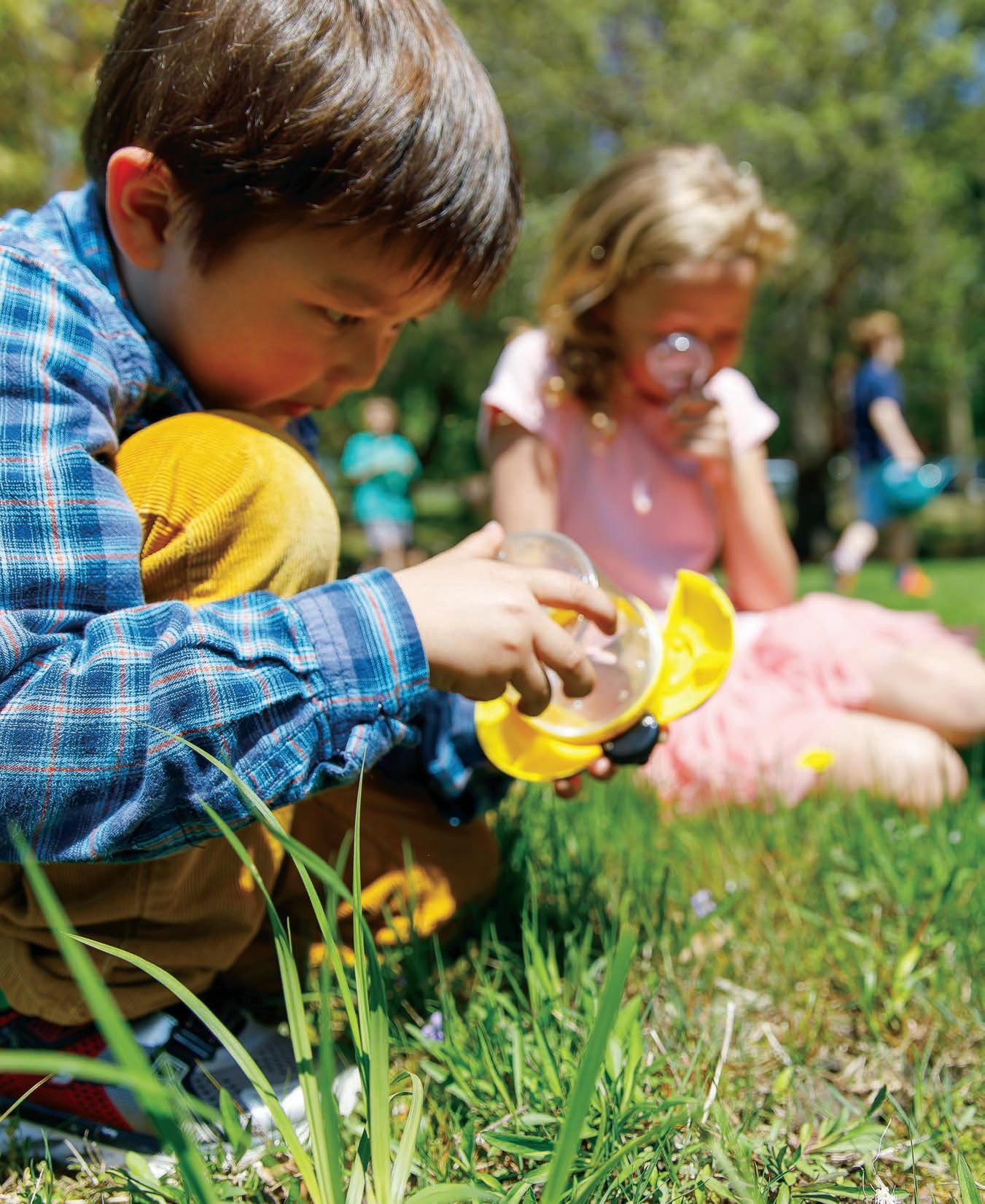
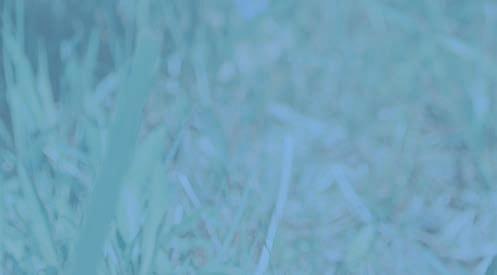
By creating environments where children are motivated to discover what they naturally do well, we promote challenges to achieve their personal best for learning now and in the future.
elementary
elementary school: engagement through experiential learning by Maria Carpenter, Director of Elementary
At Rectory, we immerse elementary students in authentic experiences that inspire them to question, explore, and seek answers. Each child is unique and may learn differently than his or her peers. We encourage them to embrace their strengths while trying a variety of classroom tools to support experiences that challenge them and support their learning style.
From a young age, children are curious about their environment and love exploring nature. We celebrate this curiosity by using science themes to immerse students in their learning through academic and related arts content areas. Each term, our classroom teachers use these topics from an earth, physical, or natural science perspective to explore with the children using the scientific method. In literacy, we choose read-aloud and chapter books to create a shared understanding of conversations. In mathematics, we use numbers and measurements to compare size, weight, and length. We teach children that learning happens all around them. We strive to give our students experiences with tools and materials that are used in real life.
Our classrooms promote a culture of questioning and deep thinking, where students learn from shared discussions with teachers and peers in environments of rock & mineral books, while a collection of
that encourage the thought process. We acknowledge each child’s uniqueness and inspire each one to find and share their passion for learning. By creating environments where children are motivated to discover what they naturally do well, we promote challenges to achieve their personal best for learning now and in the future.
As you walk into our classrooms, there is a buzz of activity as students interact with one another and explore the thoughtfully planned activities that support learning. Students have a balance of individual, small group, and large group options to weave through each day.
In Grade K-1, there may be children using
noise-reducing headphones as they sit in pairs
with a book in a shared reading experience.
Another group of children may be sorting
letters into words that were recently introduced
by their teacher. A smaller group may be
writing their own story using inventive
spelling 1 that will accompany the picture that
they created using colored pencils.
In Grade 2-3, children may be discovering properties of rocks and minerals by doing scratch tests to determine the hardness or examining minerals under magnifying glasses to identify luster and color. Another group of children may be snuggled on bean bag chairs in the library while exploring a variety specimens are close by on a tray. Yet another group may be gathered around a sensory table as they use a variety of measuring cups to sort piles of sand, clay, and humus.
Our oldest elementary students in Grade 4 are learning how to advocate for themselves as they gain responsibility for their learning, and have leadership opportunities in the elementary community. Students may gather with a group of peers outside of the classroom as they discuss their understanding of last night’s assignment in their chapter book. Post-it notes, highlighters, and templates are available to organize their thoughts and prepare for a group conversation. Children may gather at a math center to deepen their understanding of fractions using pattern blocks or fraction tiles to explore the relationship of parts to a whole. While others are using magnifying glasses and tweezers to pull apart an owl pellet as they sort and collect bones to classify with print materials.
Children have a wide variety of resources and tools available to them in our elementary spaces. They all have access to think about the topics that our nurturing, experienced teachers present to them. We are a diverse community with many views, creative ideas, and an appreciation for strong effort and collaboration —where everyone’s ideas are accepted and celebrated!
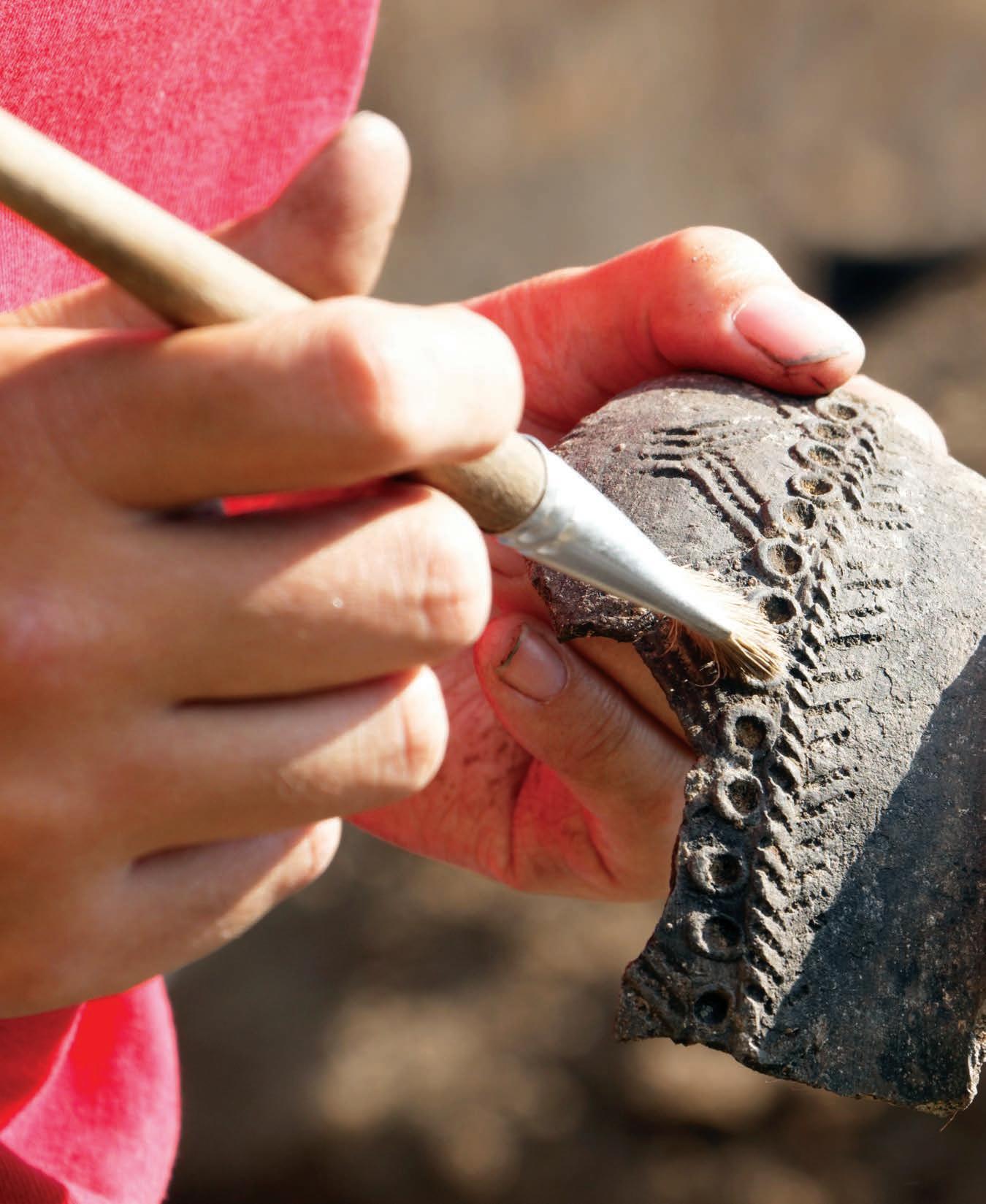
By using hands-on-learning activities and experiences that encourage critical thinking and personal connections, students create long-term memories and foster an excitement for history.

Digging for Artifacts Encourages Critical Thinking By Felicia Rodman & Jamie Haines, Middle School Faculty Members
Have you ever wondered what it’s like to be an archaeologist and dig for artifacts and fossils? Would you survive as a hunter-and-gatherer or farmer? Students at Rectory engage with and are active participants in history. By using hands-on-learning activities and experiences that encourage critical thinking and personal connections, they create long-term memories and foster an excitement for history.
In the Early Global Studies class, Mrs. Rodman tasks students with learning about the world before the time of writing through the Age of Exploration. Throughout the years, students have interacted with historical topics through designing their own civilization, taking virtual tours of significant sites such as the Lascaux caves and the Hagia Sophia, and using primary sources to design a tombstone that reflects the impact of leaders like Charlemagne.
This past year, the Haffenreffer Museum of Anthropology Culture CaraVan Program through Brown University offered Rectory students an opportunity to learn the process by working in a mock Native American village excavation site in the Hettinger Library. Each student was able to sit at different parts of the site. They learned how the area is broken down into grids, the care required in keeping artifacts intact (or as much as possible), how to use archaeological tools to uncover artifacts, how to record where artifacts are found, and how to piece together artifacts (like pottery). Within this activity, students discovered an appreciation for the time and patience needed to complete digs in real life. Students reflected on their experience, noting the difficulty of accurately interpreting what occurred at the village. Perhaps even more important, they discovered that the more we uncover, the more our histories change and that our interpretations of events may shift. They learn that perhaps there are still discoveries below our feet waiting to be found. For students to grasp that history is not set in stone but can change and shed light on new truths and understandings— even in modern times—is important in seeing history as not stagnant, but an ever-changing story of humanity and their place within it.
In Mrs. Haines’ Geography class, students learn about the elements of geography, both physical and human, and apply their learning to various regions of the world. For 6th graders, regions like sub-Saharan Africa or the Indian sub-continent can seem remote and unimportant to their lives. By using hands-on-learning activities to “experience” what others have experienced, to “walk” in their shoes and “see” from their perspective, creates emotional connections that help students see our world as a global community and fosters a sense of ownership and responsibility for it and its people. Over the years, students have created their own world and map, incorporating map skills and knowledge of landforms and water bodies; wrote a peace treaty for the Israeli-Palestinian conflict; and created a traditional meal from a country they’ve never visited and feeding friends and family in our annual “Feast of the World” fair.
library enrichment series brings learning to the students
The Library Enrichment Series first began in 2017 as a way for students to experience the hands-on exploration of an educational field trip on Rectory’s campus. Programs take place during enrichment time, thereby not disrupting academic classes. Students voluntarily sign up if they are interested in the topic, ensuring audience engagement.
We have had teachers from Mystic Aquarium present squid dissection and members from the New England Science and Sailing Foundation lead a shark dissection. Mystic Seaport taught students about rope making and how to use a sextant for navigation. We have had a rocket-building and launching class thanks to the Worcester Ecotarium and many programs from The Children’s Museum of West Hartford including live animal demonstrations, chemistry experiments, an electricity demonstration, and experiments involving liquid nitrogen, combustion, and sound. Last spring, we also had an all-school program which was held in the amphitheater and on the soccer field below demonstrating the flight and sound of birds of prey, featuring the exciting flight and hunting capability of a falcon!
Presenters have commented that they love to come to Rectory as our groups are highly engaged. This year, we are working on a program that revolves around an environmental theme.
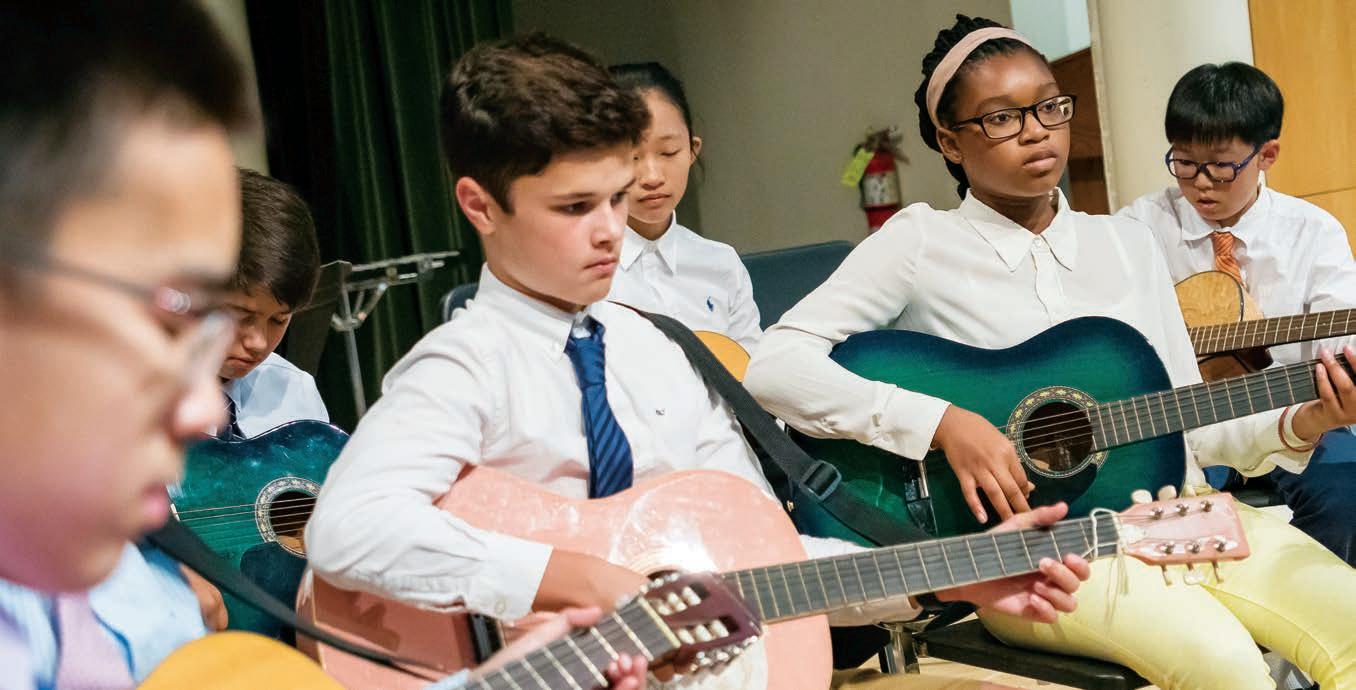
songwriting @ rectory By Maria Sangiolo, Middle School Faculty
For the past two years, I have had the great pleasure of teaching a songwriting elective to some very smart and creative young people at Rectory School. Some of them had no musical skills and some played guitar, bass guitar, and even created electronic music on their Chromebook.
The elective focuses on writing new lyrics and matching original lyrics to an existing melody, be it pop, folk, country, hip hop, or good old rock and roll. It teaches students about higher-order thinking and using original sources to write a lyrical story in song.
Last year, the class was tasked with writing two different songs to help celebrate Rectory’s upcoming Centennial. The kids had to dig deep for information and inspiration. They researched Rectory’s history with the help of Lisa Levesque. They interviewed Mr. Williams and former teachers, and as a result, they came up with two different songs that tell two different stories and express different emotions.
The “The Headmasters’ Song,” chronicles all five headmasters and their unique ways of leading and forming the lives of Rectory students. In a hip-hop-rapping style, a verse goes, “This is the headmaster’s song, five headmasters in 100 years!” In a contrasting country song set to a John Denver ballad, the sweet “100 Years” song features these lyrics: “Rectory is a century, Rectory is our
home away from home. 100 years, here in Pomfret.” The hip-hop song was written by Karl Maybank Burgdorf ‘19, Ethan G. ‘20, Mimi N. ‘22, Livie C. ‘22, and the musically gifted Alvaro A. ‘22. The melancholy ballad was penned by Alonso Sanchez ‘19, Ava S. ‘22, Chloe W. ‘22, and Clement W. ‘22, with assistance by me and Jessy white. I recorded the songs professionally this summer and they will be used in Rectory’s Centennial celebrations in the coming year! I look forward to teaching another fun songwriting elective later this year.
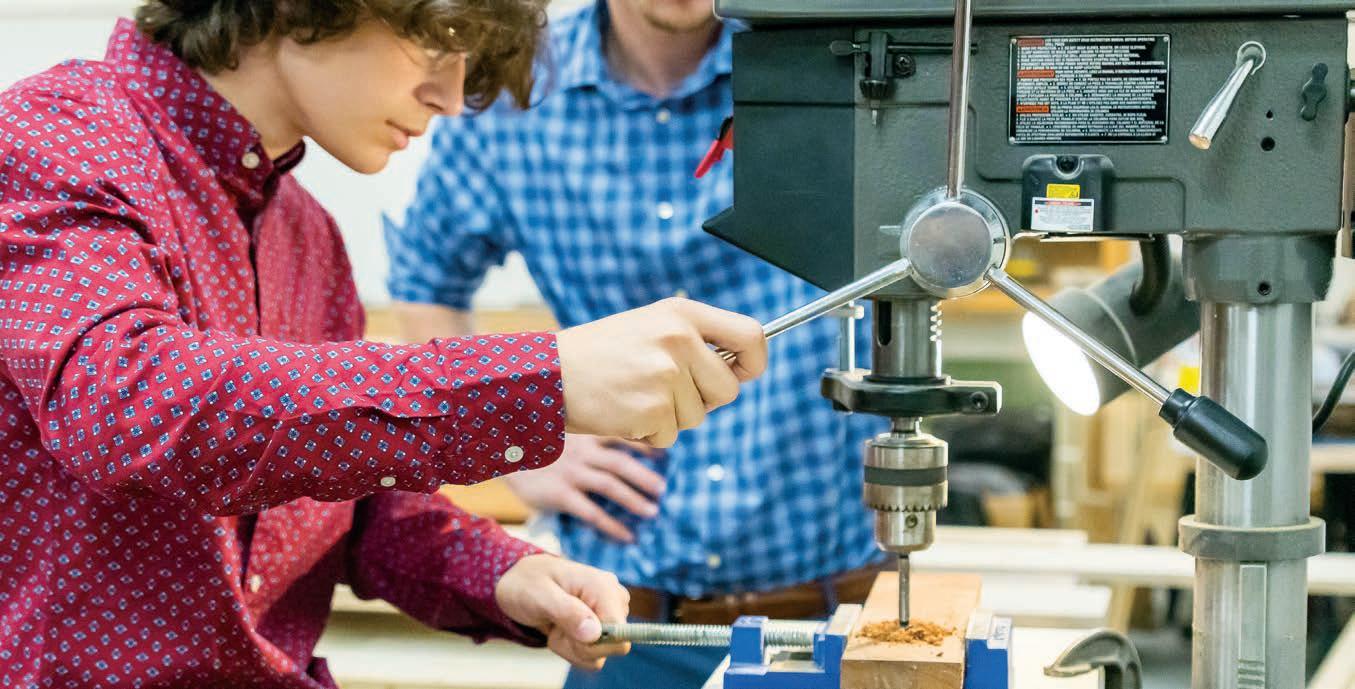
Working with Wood & Building Bridges By Josiah Fuller, Middle School Faculty
Woodshop is an excellent opportunity for students to increase their interest in fine arts into a new medium. Shop classes used to be a staple of education in most schools until the 1990s when schools cut back on arts funding. With the recent resurgence in interest at the hobby level in woodworking, the industry has seen a significant comeback.
The increased interest gave us the opportunity to provide students with the hands-on opportunity to learn how to design, plan, and build projects, building a skill that can help them later in life. Whether the interest leads to something as simple as doing a small fix around their house or as complex as becoming a professional woodworker or artist, the skills they learn in this class will set a strong foundation for the trade. The ability to create something with your hands is a cathartic and satisfying experience.
Since its reintroduction to Rectory last year following a 25-year hiatus, student interest in the program has been strong. Last year, more than 40 students participated in the introductory program. With the addition this year of Woodshop II for 9th graders, we anticipate nearly doubling that number.
Bridge building gives students the opportunity to understand why group work and developing the ability to work well in a team is incredibly important. Students work in small groups (usually 2-4 students) to collaborate and design and build a working bridge model. Their models are later tested to determine how much weight they can bear. Students are graded solely on their participation, work effort, and communication skills. This project helps demonstrate that STEM projects are not just about the end result, but more importantly, how they got there. Science and engineering is all about learning from mistakes and failures, and turning those into success.


